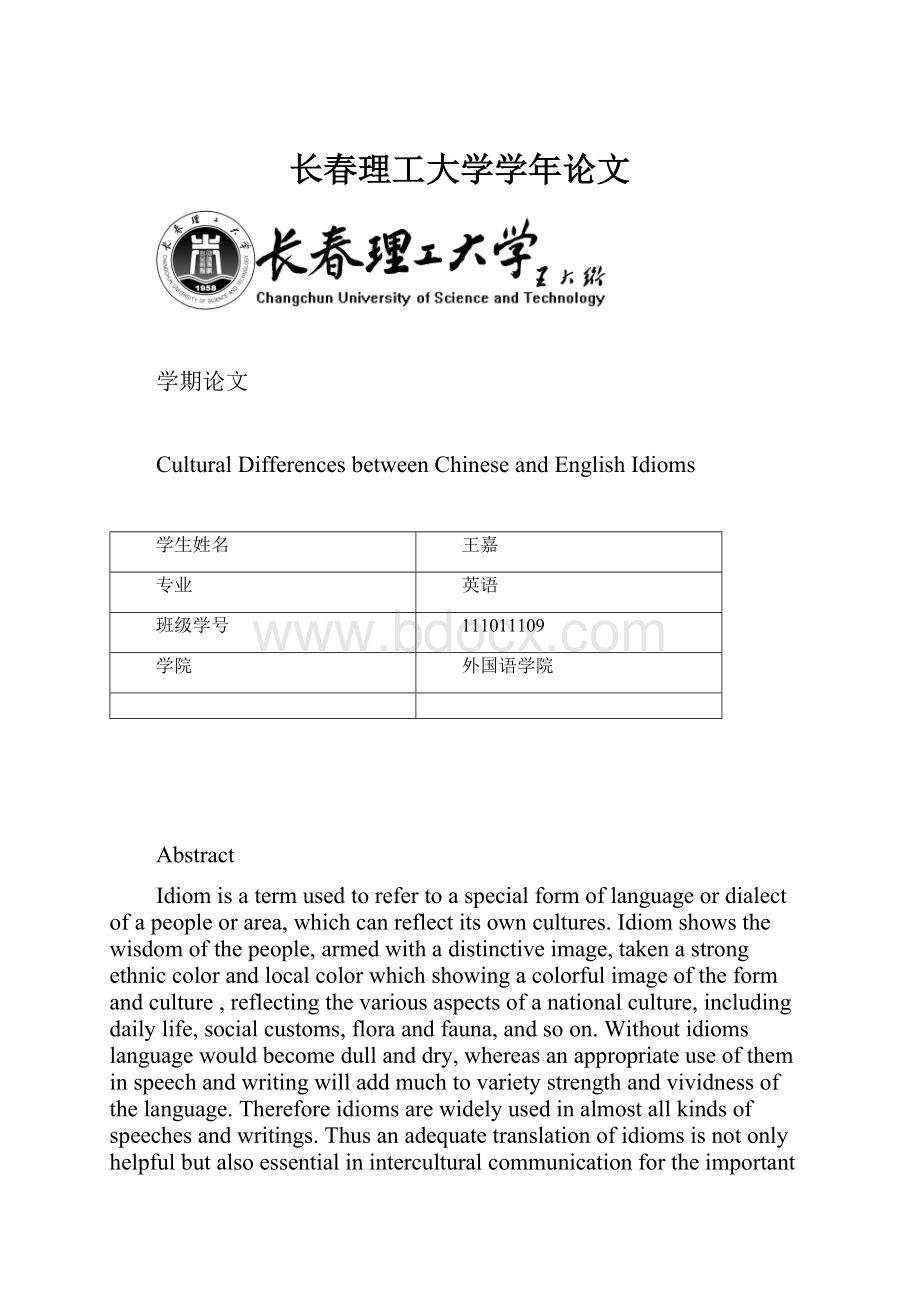长春理工大学学年论文.docx
《长春理工大学学年论文.docx》由会员分享,可在线阅读,更多相关《长春理工大学学年论文.docx(12页珍藏版)》请在冰豆网上搜索。

长春理工大学学年论文
学期论文
CulturalDifferencesbetweenChineseandEnglishIdioms
学生姓名
王嘉
专业
英语
班级学号
111011109
学院
外国语学院
Abstract
Idiomisatermusedtorefertoaspecialformoflanguageordialectofapeopleorarea,whichcanreflectitsowncultures.Idiomshowsthewisdomofthepeople,armedwithadistinctiveimage,takenastrongethniccolorandlocalcolorwhichshowingacolorfulimageoftheformandculture,reflectingthevariousaspectsofanationalculture,includingdailylife,socialcustoms,floraandfauna,andsoon.Withoutidiomslanguagewouldbecomedullanddry,whereasanappropriateuseoftheminspeechandwritingwilladdmuchtovarietystrengthandvividnessofthelanguage.Thereforeidiomsarewidelyusedinalmostallkindsofspeechesandwritings.Thusanadequatetranslationofidiomsisnotonlyhelpfulbutalsoessentialininterculturalcommunicationfortheimportantpositionthatidiomholdinlanguageuse.ThispaperattemptstomakeabriefcomparativestudyoftheculturesembodiedinChineseandEnglishidiomsandexplorestheroleofthecultureinunderstandingandrenderingofbothEnglishandChineseidioms.
Keywords:
idioms;culture;thetranslationsofidioms.
摘要
习语是一个国家或民族语言、方言的一种特殊形式,可以反映出该地区的生活条件和文化。
习语体现了人民的智慧,形象鲜明,具有浓厚的民族色彩和地方色彩,其形式多样,展现出丰富多彩的文化。
习语反映出了一个民族文化的各个方面,包括日常生活,社会习俗,动物和植物等等。
没有习语的话,语言将会变得枯燥无味,而在演讲和写作的时候正确地使用习语将能使语言更加生动、形象,更有说服力。
因此,习语翻译不仅有助于促进跨文化交流,同时在语言使用中占据着重要的地位。
本文将对中西方的习语文化做简要的对比研究,并探讨文化在英语和汉语习语理解和渲染的作用。
关键词:
习语;文化;习语翻译。
Content
AbstractI
摘要II
ContentIII
Ⅰ.Introduction1
Ⅱ.LiteratureReview1
Ⅲ.ABriefIntroductionAboutIdiom2
3.1Definitionsofidiom2
3.2CharacteristicsofIdioms2
3.3Formsofidioms2
Ⅳ.Understandingidiomsfromculturaldifferences4
4.1Differentoriginalandnationalcoloring4
4.2Differentlivingcondition4
4.3Differentreligiousbeliefs5
4.4Differentlifeexperienceofpeople5
Ⅴ.Translationmethodsofidioms6
5.1Theliteralapproach6
5.2Literaltranslationplusannotation6
5.3Image-shifttranslation7
5.4Theapproachofadditionandomission7
Ⅵ.Conclusion8
Reference9
Ⅰ.Introduction
Idiomsaretheessenceoflanguage,whichhavestrongnationalcolorsanddistinctiveculturalconnotation.TherearevariousidiomsbothinChineseandEnglish.Thedifferencesaresignificant.Themainreasonisthattheidiomsareculture-loaded.Languageisagreatpartofculture,andidiomsareconsideredasthecreamofalanguage.Thereforecultureisfullydisplayedintheimagesandemotionsofidioms.Hence,itisnecessarytohaveacomparativestudyofEnglishandChineseidiomsfromtheperspectiveofculturalsources.WhenexploringEnglishandChineseidioms,oneshouldpayattentiontotheculturalbackgroundofidioms.
Speakingofculture,it’saveryextensiveconceptandverydifficulttodefineitstrictlyandaccurately,becausecultureinvolvestoomuch.Itmixesupwiththematter,socialrelations,spirit,art,landsignandcustom.Everycountryhasitsownethnicgroups,geographicallocation,religiousbeliefs,values,politicalsystemsandsoon.Alltheseformthedifferencesofnationalculture,whicharealsocertainlyembodiedinlanguage.Theinfluenceofcultureonlanguagebringsdifficultiestotranslating.Thelackofculturalawarenessonthepartofthetranslatorsisoftenthecauseoferrorsordefectsofculturalnatureintranslating.
ChineseandEnglishhavedevelopedtheabundantandvarietyofidioms,whichmakethemselvesmorevivid,moresuccinctandmoreexpressive.Theymainlycomefromthelaboringpeople,fromancientlanguagesorforeignlanguages,inwhichliterature,history,religionandsportsetc,havegivenrisetomanysuchwonderfulphrasesandsentencesconcerned.Withcomplexityinculture,idiomstakemanydifferentformsorstructures,andconstituteobstaclestotheirtranslation.Thereforehowtosolvetheculturalfactorsinidiomsisatouchstoneofsuccessfulrenderingofidioms.
Ⅱ.LiteratureReview
Withthedevelopmentofidioms,theyhavebeenpaidattentiontobyanumberofresearchersinrealearnest.Alotofworksonidiomshaveappeared.InCommunicationBetweenCultures,LarryA.Samovar(Larry,2004)pointsoutthatthecloserelationshipbetweenlanguageandculture,andhealsoshowsclearlytheimportanceoflanguagetothestudyofinterculturalcommunication,whichisinaccordancewithKramsch’sideasinhisbookLanguageandCultural(Kramsch,2000).Fernando(Fernando,2000)resortstoIdiomsandIdiomaticitytoexplainthefunctionsofidioms.
Althoughthosescholarsdomanyendeavorsinthestudyofidioms,however,mostofthemarefocusontranslationandfunctionsandfewofthemdiscussthedifferencesinidiomsclearly.Therefore,theauthorwantstoanalyzetheculturaldifferencesfromsomedetailedfactsinthispaper.Besides,theauthorhopesthisarticlecandrawpeople’sattentiontotheculturaldifferencesinidioms.
Ⅲ.ABriefIntroductionAboutIdiom
3.1Definitionsofidiom
Anidiomisaphrasewhichhasameaningthatiscommonlyunderstoodbyspeakersofthelanguage,butwhosemeaningisoftendifferentfromthenormalmeaningofthewords.
3.2CharacteristicsofIdioms
(1)Semanticunity;
1)idiomseachconsistsofmorethanoneword,buteachisasemanticunity.
2)Intheidiomwordshavelosttheirindividualidentity,i.e.theirmeanings,arenotoftenrecognizableinthemeaningofthewholeidiom.
3)Quiteoftentheidiomfunctionsasoneword.Forinstance,“tillthecowscomehome”means“foreverasanadverb”.
(2)Structuralstability.
1)Theconstituentsofidiomscannotbereplaced.Take“inabrownstudy”forexample.Usedasanidiom,itmeans“deepinthought”,thestructureisfixed.Inthesameway,“lipservice”whichmeans“supportonlyinwords,notinfact”isnottobechangedinto“mouthservice”.
2)Thewordordercannotbeinvertedorchanged.Forexample,“bytwosandthrees”and“titfortat”arenottobeturnedinto“bythreesandtwos”and“tatfortit”.
3)Theconstituentsofanidiomcannotbedeletedoraddedto,notevenanarticle.Forinstance,“outofthequestion”means“impossible”.Ifthearticle“the”isdeleted,theidiomaticwillbelostanditwillsignify“noquestion”instead.
3.3Formsofidioms
Idiomsusuallyincludesetphrases、allusions、proverbs、slang、sayings、colloquialismandsoon.
(1)Setphrases
Onemostimportantgroupofidiomsaresetphraseswhoseformissetandmanyofthemareratherrigidandcannotshowupinanyotherforms.ThereisaninexhaustiblestorehouseofsetphrasesthatplayanimportantroleinEnglishlanguage.Ishallselectoneofthemwithculturaltraces.Forexample,theoriginof“tokickthebucket”canbetracedbacktoareligiousceremonyofbaptisminChristianity.AsfarasaChristianisconcerned,his/herimportantthreestages,birth,marriageanddeath,arecloselyconnectedwithareligiousceremony:
baptism.AChristianneedstoreceivebaptismfromanadministratorwhenhe/shewasborn,getmarriedinthechurchwithblessingsofacertainministerandbebaptizedagainwhenhe/sheisgoingtodie”.Sotheidiom“kickthebucket”isaeuphemisticexpressionconnoting“todie”referringtothedeathofaChristianintheceremonyofbeingbaptized.
(2)Allusions
Allusionsofidiomsareactuallyoriginsandnationalcharacteristicsofidioms.Onaccountofthedifferentsocialbackground,customsandreligious,someidiomsaresuretohaveallusionstomythandlegend,historyandclassic.Theirmeaningsaremuchmoreremotefromtheirliteralsenses.Withoutknowledgeoftheallusionsmadeinidiomswecanhardlyreadbetweenthelinesandcatchwhattheyimply.Tounderstandtheidiomsofthiskind,knowledgeoftheetymologyofidiomsisindispensable.OnlyasmallpartofEnglishidioms,itissaid,drawonsourcesfromthelegendofGreeceandRome,mostofthemareofbiblicalorigin.
(3)Proverbs
Proverbisoftendefinedasthewisdomofmanyandthewitofone,statingcommonlyexperiencedorforthepurposeofgivingwiseadvicetoothers.Proverbsarethewisdomofpeople,soitiscommonpeoplewhohavecreatedagreatnumberofproverbsthatareterse,colloquial,andvividandchargedwithlifethroughtheirpracticalwork.Theirvariedproverbsarefromallwalksoflife.Herearesometypicalonesreflectiveofcommonpeople’slivesasfollows:
Sailorswillsay:
”Inacalmseaeverymanisapilot.”
Carpenterswillsay:
”Suchcarpenters,suchchips.”
Cobblersmaysay:
”Thecobbler’swifeistheworstshod”.
(4)Slang
Slangexpressionsaredialectic,vulgarandcolloquiallanguagedrawingnumeroussourcesfromtheshoptalkofeveryprofession:
trade,sport,school,socialgroup,etc.Theydrawonsourcefromlocalpeople’slifeexperiencesortheircustomsandarewidelyusedininformalspeechandwritingsuchasdrama,TVserials,movies,monologueinthenovelbutarerarelyusedinformalcontexts.
Ⅳ.Understandingidiomsfromculturaldifferences
4.1Differentoriginalandnationalcoloring
Theoriginsofidiomsarevaried,butthechiefsourcesarefromthespeechofthecommonpeople.Ordinarypeople,suchaspilots,hunters,farmers,workers,housewivesandcooks,createmanyidioms.Overalongperiodoftime,thesepeoplehavecreatedagreatnumberofidioms.Theseidiomsareterse,colloquial,andvividandchargedwithlife.Andbeforelongtheyacquireawideapplicationtoanalogoussituationsineverydaylife.Littlebylittlethemostvividandmostusefuloftheseidiomsmaketheirwayfrompopularspeechintothestandardlanguage,andfinallycometobeuniversallyunderstood.Sufficeittogiveafewexamplesbelow:
1)Astrawshowswhichwaythewindblows.
2)Asamanso